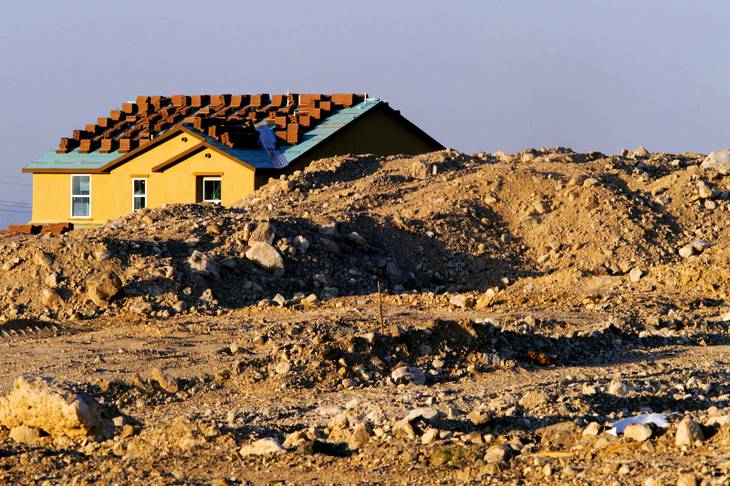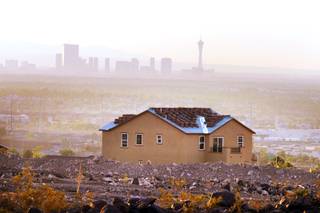Related stories
- Las Vegas real estate: Houses you can (or could) buy for under $150,000 (04-10-2012)
- Low prices, low interest rates driving home sales across valley, Realtors say (04-10-2012)
- Las Vegas home prices sink to 1997 level, Standard & Poor’s reports (01-31-2012)
- More Sun real estate news
- More Sun housing news
Las Vegas homebuilders can’t build houses fast enough these days to keep up with buyers’ demand.
Yes, you read that right.
The valley’s new home market is booming. Developers say they haven’t built, or sold, so many houses in years.
“I’m as much as 80 to 90 percent higher in volume than last year,” said Robert Beville, president of Harmony Homes. “I’ll probably more than double my deliveries this year.”
Applications for new home permits in Henderson, North Las Vegas, Las Vegas and Clark County have increased 40 percent from last year, according to Home Builders Research. Prices have risen 6 percent to an average of $201,000, and sales have jumped 20 percent. By June, experts expect to see 500 new-home closings a month.
“Some of the builders are selling one or more new homes a week,” said Kolleen Kelley, president of the Greater Las Vegas Association of Realtors. “That’s up considerably from last year.”
There’s always a market for new houses. Certain buyers prefer new residences so they can choose layouts and customize finishes. They don’t want to worry about inheriting previous owners’ problems.
But the demographic is growing mostly out of necessity. A shrinking inventory of existing homes in the valley is forcing buyers who might typically prefer older homes to buy new.
There are 20 percent fewer single-family homes available on the Multiple Listing Service today than last year. There are 30 percent fewer condos and townhouses.
Properties that a year ago would have sat on the market for weeks or months are now getting as many as 15 offers, Kelley said. List prices have become minimums. Most existing homes are selling for thousands more.
That’s if buyers can get them. A little more than 5,000 units are available for sale right now, the fewest since 2006 and an almost 60 percent drop from last year. Market conditions have combined to make it difficult for most buyers to purchase older homes.
Inventory began to shrink rapidly at the end of last year when a new state law took effect requiring lenders to prove they have the legal right to foreclose on properties. Legislators intended to curb fraud with the bill and hoped it would reduce robo-signings. Instead, it scared banks into limiting foreclosures rather than risk breaking new, stricter rules and facing potential prosecution.
Last month, there were only 258 bank repossessions in the valley, the fewest on record in two decades, according to SalesTraq.
At the same time, banks are approving short sales at a brisker pace. Investors unable to find foreclosed properties are snatching them up. Home Builders Research reports that 90 percent of available short-sale homes have contingency offers pending.
Combine that with the fact that 54 percent of today’s buyers are cash investors, and it’s nearly impossible for a conventional buyer with a small down payment and mortgage to find a house to buy. When banks or sellers have multiple offers on a home, they most often choose the cash investor over a buyer with a mortgage. Who would turn down money in hand for 30 years of payments?
Generally speaking, investors aren’t interested in buying new homes. They can’t make the same kind of profit renting them as they can with older, cheaper homes.
Drive down Horizon Ridge Parkway in Henderson, and it’s easy to forget this is 2012. It feels more like 2006. New houses are popping up left and right.
At Gibson Road alone, one intersection is home to three new housing projects. KB and Ryland Homes are developing a swath of desert into plots for more than 200 single-family houses. Across the street, heavy equipment operators are flattening dirt for a third housing complex.
A mile down the road, Lennar Homes is hard at work building a neighborhood of multigenerational homes. Across town at Mountain’s Edge, Ryland Homes recently debuted Maravilla Courtyards, the region’s first housing development with roof-top decks.
Ryland is selling houses in 12 neighborhoods. Harmony is building in 11. The company already sold out of three neighborhoods this year.
“The single largest impact has been houses under $200,000,” Beville said. “Homes in the $130,000 to $190,000 (range) are getting a lot of love. The ones in the $200,000 to $300,000 are getting a little bit less.
“There are buyers in that range who can afford that mortgage and just can’t find what they are looking for in existing homes. It has pushed them into the new home market.”
For the first time in five years, homebuilders are raising prices as developments sell out. Typically, the first homes built in a neighborhood sell for less than the last ones. Beville said Harmony Homes had increased prices from 1 percent to 10 percent in its developments.
Even so, don’t expect to see prices peak to 2006 levels. Even if demand could justify it, developers have to work with lenders in mind.
“They can only raise their prices so much. The problem is getting appraisals to match those prices,” Kelley said.
Still, there’s profit to be made. Most of the land being developed has changed hands since it was bought during the boom. The developers building on it now, in most cases, acquired it empty or half developed from others who paid a premium a few years ago.
“Every one of our projects had started and was taken over from banks or builders,” Beville said. Harmony bought one development from Pardee Homes, another from Story Book.
Perhaps the biggest winners in the revived housing market are construction workers, particularly specialists. Framers, for example, are in high demand. Many left the state when the housing market deflated, and the ones who stayed took jobs in other fields. Now, homebuilders are entering bidding wars to hire those who are left.
The housing resurgence hasn’t created a job boom like it did five years ago, but it is helping to put people to work. Builders say they are “cautiously optimistic” that current market conditions will remain and are beefing up their staff levels slowly. Most have operated with skeleton crews since the bust.
Naysayers may grumble that another bust is imminent. With a glut of inventory lurking in the shadows, they worry the market will be flooded with new and existing homes once banks start releasing foreclosures again.
Kelley doubts it. Developers are, for the most part, building on demand, she said, and have learned lessons about speculation.
“They have a good sense of the demand going a few months out,” she said. “I think we are headed in the right direction.”

